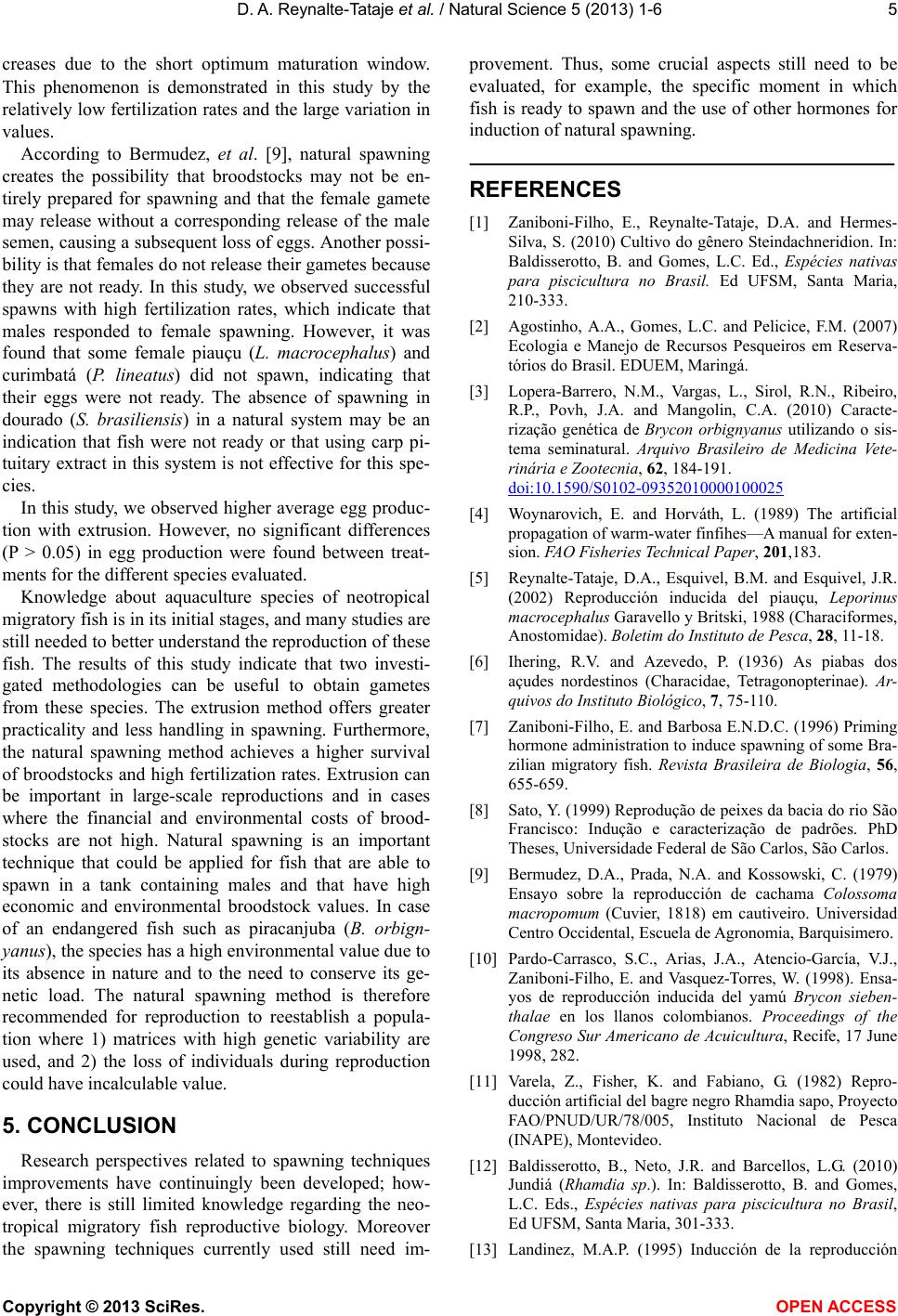
D. A. Reynalte-Tat aje et al. / Natural Science 5 (2013) 1-6 5
creases due to the short optimum maturation window.
This phenomenon is demonstrated in this study by the
relatively low fertilization rates and the large variation in
values.
According to Bermudez, et al. [9], natural spawning
creates the possibility that broodstocks may not be en-
tirely prepared for spawning and that the female gamete
may release without a corresponding release of the male
semen, causing a subsequent loss of eggs. Another possi-
bility is that females do not release their gametes because
they are not ready. In this study, we observed successful
spawns with high fertilization rates, which indicate that
males responded to female spawning. However, it was
found that some female piauçu (L. macrocephalus) and
curimbatá (P. lineatus) did not spawn, indicating that
their eggs were not ready. The absence of spawning in
dourado (S. brasiliensis) in a natural system may be an
indication that fish were not ready or that using carp pi-
tuitary extract in this system is not effective for this spe-
cies.
In this study, we observed higher average egg produc-
tion with extrusion. However, no significant differences
(P > 0.05) in egg production were found between treat-
ments for the different species evaluated.
Knowledge about aquaculture species of neotropical
migratory fish is in its initial stages, and many studies are
still needed to better understand the reproduction of these
fish. The results of this study indicate that two investi-
gated methodologies can be useful to obtain gametes
from these species. The extrusion method offers greater
practicality and less handling in spawning. Furthermore,
the natural spawning method achieves a higher survival
of broodsto cks and high fertilization rates. Extrusion can
be important in large-scale reproductions and in cases
where the financial and environmental costs of brood-
stocks are not high. Natural spawning is an important
technique that could be applied for fish that are able to
spawn in a tank containing males and that have high
economic and environmental broodstock values. In case
of an endangered fish such as piracanjuba (B. orbign-
yanus), the species has a high environmental value due to
its absence in nature and to the need to conserve its ge-
netic load. The natural spawning method is therefore
recommended for reproduction to reestablish a popula-
tion where 1) matrices with high genetic variability are
used, and 2) the loss of individuals during reproduction
could have inc al c ul abl e val ue.
5. CONCLUSION
Research perspectives related to spawning techniques
improvements have continuingly been developed; how-
ever, there is still limited knowledge regarding the neo-
tropical migratory fish reproductive biology. Moreover
the spawning techniques currently used still need im-
provement. Thus, some crucial aspects still need to be
evaluated, for example, the specific moment in which
fish is ready to spawn and the use of other hormones for
induction of natural spawn ing.
REFERENCES
[1] Zaniboni-Filho, E., Reynalte-Tataje, D.A. and Hermes-
Silva, S. (2010) Cultivo do gênero Steindachneridion. In:
Baldisserotto, B. and Gomes, L.C. Ed., Espécies nativas
para piscicultura no Brasil. Ed UFSM, Santa Maria,
210-333.
[2] Agostinho, A.A., Gomes, L.C. and Pelicice, F.M. (2007)
Ecologia e Manejo de Recursos Pesqueiros em Reserva-
tórios do Brasil. EDUEM, Maringá.
[3] Lopera-Barrero, N.M., Vargas, L., Sirol, R.N., Ribeiro,
R.P., Povh, J.A. and Mangolin, C.A. (2010) Caracte-
rização genética de Brycon orbignyanus utilizando o sis-
tema seminatural. Arquivo Brasileiro de Medicina Vete-
rinária e Zootecnia, 62, 184-191.
doi:10.1590/S0102-09352010000100025
[4] Woynarovich, E. and Horváth, L. (1989) The artificial
propagation of warm-water finfihes—A manual for exten-
sion. FAO Fisheries Technical Paper, 201,183.
[5] Reynalte-Tataje, D.A., Esquivel, B.M. and Esquivel, J.R.
(2002) Reproducción inducida del piauçu, Leporinus
macrocephalus Garavello y Britski, 1988 (Characiformes,
Anostomidae). Boletim do Instituto de Pesca, 28, 11-18.
[6] Ihering, R.V. and Azevedo, P. (1936) As piabas dos
açudes nordestinos (Characidae, Tetragonopterinae). Ar-
quivos do Instituto Biológico, 7, 75-110.
[7] Zaniboni-Filho, E. and Barbosa E.N.D.C. (1996) Priming
hormone administration to induce spawning of some Bra-
zilian migratory fish. Revista Brasileira de Biologia, 56,
655-659.
[8] Sato, Y. (1999) Reprodução de peixes da bacia do rio São
Francisco: Indução e caracterização de padrões. PhD
Theses, Universidade Federal de São Carlos, São Carlos.
[9] Bermudez, D.A., Prada, N.A. and Kossowski, C. (1979)
Ensayo sobre la reproducción de cachama Colossoma
macropomum (Cuvier, 1818) em cautiveiro. Universidad
Centro Occidental, Escuela de Agronomia, Barquisimero.
[10] Pardo-Carrasco, S.C., Arias, J.A., Atencio-García, V.J.,
Zaniboni-Filho, E. and Vasquez-Torres, W. (1998). Ensa-
yos de reproducción inducida del yamú Brycon sieben-
thalae en los llanos colombianos. Proceedings of the
Congreso Sur Americano de Acuicultura, Recife, 17 June
1998, 282.
[11] Varela, Z., Fisher, K. and Fabiano, G. (1982) Repro-
ducción artificial del bagre negro Rhamdia sapo, Proyecto
FAO/PNUD/UR/78/005, Instituto Nacional de Pesca
(INAPE), Montevideo.
[12] Baldisserotto, B., Neto, J.R. and Barcellos, L.G. (2010)
Jundiá (Rhamdia sp.). In: Baldisserotto, B. and Gomes,
L.C. Eds., Espécies nativas para piscicultura no Brasil,
Ed UFSM, Santa Maria, 301-333.
[13] Landinez, M.A.P. (1995) Inducción de la reproducción
Copyright © 2013 SciRes. OPEN A CCESS